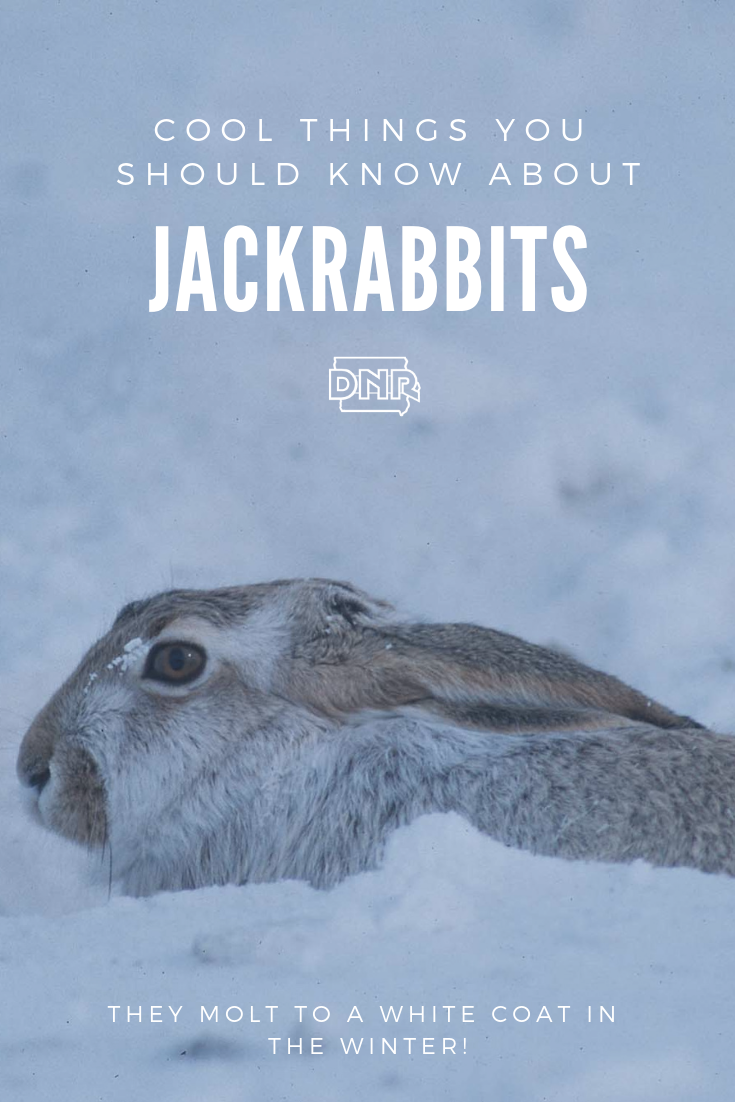Once a well-known resident of Iowa’s grasslands, the white-tailed jackrabbit (Lepus townsendii) calls Iowa home in much lower numbers today due to loss of habitat. However, they still remain one of Iowa’s most interesting mammals!
Life in the fast lane
One of Iowa’s fastest animals, jackrabbits can run up to 35 miles per hour while covering up to 15 feet in a single bound!

Don’t call me rabbit
Despite the name, the jackrabbit is really a hare. Much larger than eastern cottontail rabbits, jackrabbits have longer ears and longer legs. With yellowish to grey/brown fur on their backs, jackrabbits usually have white or pale grey undersides. In the northern parts of its range (including Iowa), they will molt to an all-white coat in the winter. Their tails are always white and the tips of the ears are black, regardless of the time of year.
Hare-y situation
Among the most solitary of rabbits and hares, Iowa’s jackrabbits don’t have much company anymore. Jackrabbits initially may have expanded their range from the northwestern part of the state into much of Iowa during settlement as prairie turned into farmland. However, as row crop cultivation intensified and small grains and grassland areas in the state declined during the 20th century, the population and range in Iowa shrunk. Today, jackrabbits are classified as a species of conservation need in Iowa.
Word of the day: crepuscular
Like the cottontail rabbit, the jackrabbit is considered nocturnal as it’s least active during the day. But, as with many mammals, they show a crepuscular tendency - that means, like deer, they’re most active at dusk and dawn.
Home sweet grassland
Creatures of open short grasslands, white-tailed jackrabbits avoid timber in all but the harshest of winter weather. You will not find them in tall trees or timber, but they're not opposed to using brush - like plum thickets or raspberry patches - when the winter gets rough. They are a tough prairie native, but today their range is highly restricted and scattered in Iowa because of the loss of short grasslands and small grain habitats where they once thrived.
Free-range parenting
Hares, in general, are among the most hands-off of mammal parents. Nests are often little more than scratched out depressions. Three to six young are born fully furred with eyes open and capable of moving immediately. Mothers do not tend to their young and only return for a few minutes once or twice a day to nurse until they are weaned - just one month later. Breeding begins in late February and will continue until early fall, and as many as four litters may be born in a season, although this is limited by climate and environmental conditions.
Salad with a side of salad
The jackrabbit diet relies almost entirely on plants. They eat primarily grasses and broad-leaved plants depending upon season and availability, with a lesser amount of browse (woody plants), although the importance of shrubs (mostly bark and buds) increases in the winter. They are capable of damaging shrubs or trees, but their scarcity limits their impact. In fall and winter they will also readily consume waste grains, like corn and soybeans.
Send your sightings
We track jackrabbit sightings - so if you see one, send along your name, date and where you saw the critter (township, section and range if at all possible) to Todd.Bogenschutz@dnr.iowa.gov.